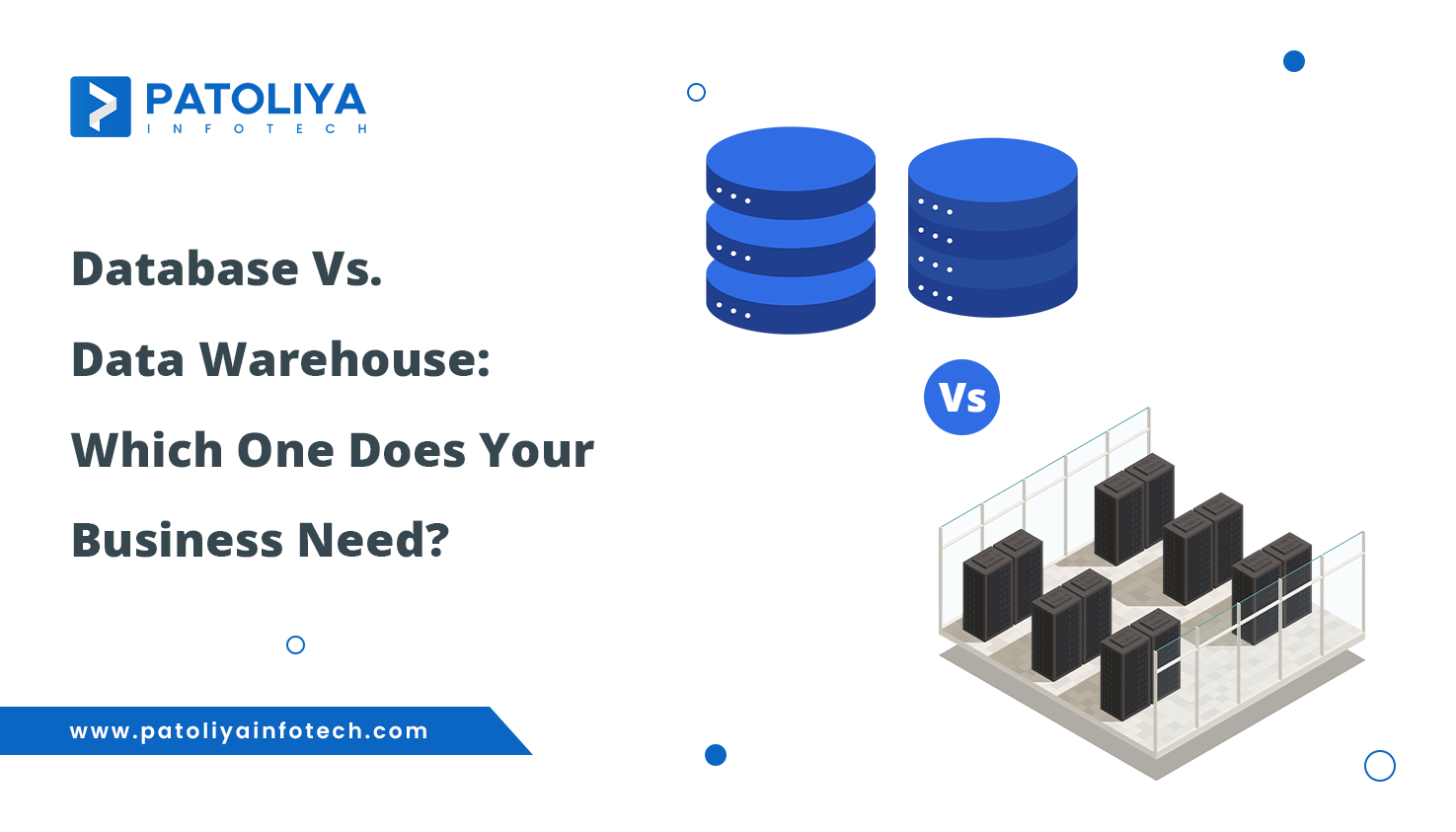Difference Between Database and Data Warehouse with Example

Table of Contents
Choosing how to use and keep it effectively may be like solving a large puzzle. A database vs data warehouse: which is better? This is not just technical jargon; it may have an important impact on how your company functions and makes decisions.
Despite having similar names, databases and data warehouses serve rather diverse functions. Transactions and records that require frequent changes are among the commonplace items that databases monitor. Meanwhile, the goal of data warehouses is to go deeper. They make it possible for you to see patterns and trends in vast volumes of data that might help you formulate a plan.
Anyone hoping to make more informed, data-driven decisions will find understanding the difference revolutionary, not just for IT professionals. Let’s explore the strengths of each and why your company might benefit greatly from recognizing these differences.
What is a Database?
A digital file cabinet, like a database, is intended to store, organize, and manage data so that it can be easily accessed and manipulated. Whether it’s customer information, sales records, or inventories, the database stores all your data in one place, accessible whenever you need it.
Why Do We Use Databases?
Databases are mostly used to handle routine data processing. It works well for activities that call for flexibility and limited, fast searches. A database is therefore made for tasks that need you to add, modify, or retrieve particular data on a regular basis (such checking a customer's account or altering stock levels).
Key Characteristics of Databases
- Real-Time Updates: Databases are made to rapidly reflect any new or updated information since they deal with constantly changing data.
- Structured Data: Databases, which are often organized in tables, make it easier to find specific information quickly.
- Transactional Processing: They are made to process orders and handle financial transactions, among other fast, specific activities, without sluggishness.
Where Are Databases Commonly Used?
Databases are everywhere in our daily lives. They power things like:
- Banking Systems: Recording every transaction so that account balances are updated quickly.
- Retail & Ecommerce: Arranging inventory levels, Customer orders, and Shipment details.
- Healthcare: Retaining patient data on file for easy access and maintenance.
Databases are mostly used to make sure that the information you depend on every day keeps working correctly. They are crucial for any company that wants to closely monitor real-time data because of their speed, accuracy, and efficiency.
Enter the era of corporate expansion! Discover how SaaS can help you achieve the full potential of your business. Continue reading!
What is a Data Warehouse?
Consider a data warehouse as the main location where all of an organization's data is gathered to offer thorough insights. In contrast to databases that handle normal activities, data warehouses are designed to gather, store, and analyze vast volumes of historical data over time. They are also the ideal resource for analyzing, identifying patterns, models, and strategy formulation.
Why Do We Use Data Warehouses?
Data warehouses are designed to give businesses a precise view of their data throughout time. Because it is made for in-depth analysis rather than tracking individual behavior, it is perfect for reporting, forecasting, and strategic decision-making based on historical data.
Key Characteristics of Data Warehouses
- Optimized for Analysis: Data warehouses are structured to support complex queries and analysis, so users can pull insights from huge datasets.
- Read-Heavy System: Because data warehouses store historical data that does not change all the time, they are designed to efficiently handle large read-only queries.
- Consolidated Data: Data is pulled from multiple sources (sales, marketing, and customer service) into one location, making it easier to get a holistic view.
Where Are Data Warehouses Commonly Used?
For companies that depend on data for strategy and planning, data warehouses are essential. They are frequently employed for:
- Business Intelligence and Reporting: Generating reports that give executives insight on the company's continuous performance.
- Financial Forecasting: To develop more precise forecasts, historical sales and patterns are examined.
- Customer Insights: Researching consumer behavior across several touchpoints in order to enhance goods and services.
Visit a data warehouse if you want to learn more about the history of the data. Through the analysis of historical data and the identification of trends that might not always be obvious on a daily basis, this tool is meant to assist businesses in making wise, long-term decisions.
From improved security to personalized services, digital finance is reshaping the industry. Dive into the benefits and discover how you can optimize your financial operations for success.
Major Differences Between Databases and Data Warehouses
| Feature | Database | Data Warehouse |
| Purpose and Functionality | Supports transactional data management and day-to-day operations (e.g., orders, customer information). emphasizes the speed and quality of real-time data for operational application. | ideal for storing and analyzing historical data over an extended period of time. intended to produce insights, find patterns, and aid in corporate intelligence and strategic decision-making. |
| Transactional vs. Analytical Processing | Transactional (OLTP): manages a large number of quick, brief transactions (inserts, updates, and deletes) smoothly. centered on routine duties such as processing orders, completing bank transactions, or updating customers. | Analytical (OLAP): designed for extensive dataset analysis and sophisticated, read-intensive queries. supports analytical, reporting, and data mining activities to help with company planning and forecasting. |
| Data Structure and Organization | Structured: Organized in normalized tables with an importance on speedy retrieval and effective data entry for real-time changes. In order to avoid redundancy and preserve accuracy, data is extensively organized. | Flexible Structure: simplifies intricate analytical queries by organizing data in multidimensional or denormalized forms. often blends several data formats from many sources to facilitate cross-functional analysis. |
| Normalization vs. Denormalization | Normalized: Data is arranged logically in smaller tables, which minimizes duplication and maximizes storage capacity. Data integrity is guaranteed since every data entry is distinct. | Denormalized: Grouping data enhances read productivity and enables quicker analytical queries. makes data easier to query and analyze for insights at the expense of some storage efficiency. |
| Data Volume and Scalability | Ideal for handling moderate amounts of transactional data while emphasizing real-time processing. handles numerous transactions with a modest degree of scalability, but it is not designed for extensive analytics. | Designed to manage enormous historical data volumes and information. quickly expands to meet expanding data requirements, particularly for analysis involving several data sources and long time periods. |
| Handling Large Datasets | Primarily made to handle frequent, smaller transactions as opposed to big databases. Complex searches or significant data analysis may result in decreased performance. | Designed especially to handle large datasets, allowing for in-depth research and queries to be handled quickly even when dealing with enormous amounts of data. |
| Integration and Data Sources | Usually focuses on a certain sort of data, such as inventory or client orders, and mixes data from a single source, application, or department. | Gather information from several sources in various departments (such as marketing, sales, and customer service), providing a cohesive picture of the company for comprehensive analysis and decision-making. |
| Combining Multiple Data Streams | Maintained a simplified workflow for transactional changes by concentrating mostly on a single data stream at a time. | Integrates several data sources into one environment, allowing for cross-departmental and cross-data type analysis for deeper insights and trend identification. |
| Querying and Reporting Capabilities | Simple, Fast Queries: Optimized for quick, repetitive transactions and simple lookups. Queries are fast but limited in analytical depth. | Complex, Analytical Queries: Supports complicated searches that call for a great deal of filtering, aggregation, and multi-dimensional analysis; ideal for creating dashboards, reports, and KPIs. |
| Types of Queries Supported | Supports short, transactional queries to quickly access or modify individual records (e.g., checking order status, updating inventory). | Supports sophisticated analytical queries for long-term data analysis, including forecasting, trend analysis, and comprehensive reporting for big datasets. |
When to Use a Database vs Data Warehouse: Choosing the Right Solution for Your Needs
The decision between a database and a data warehouse may be challenging, but in the end, it comes down to knowing your objectives and the kind of data processing you must perform. While databases are made to support transactions in real time, data warehouses are made to offer in-depth analysis and strategic insights. Each has a unique function. How to choose the best option for your unique situation is explained here.
1. If You Need Real-Time Data Access for Operations, Go with a Database
If you handle a lot of transactions that require regular updates, databases are your best option. They are perfect for circumstances when up-to-date information is essential since they are made for fast, real-time access. Among the examples are:
- Customer Management: Preserving current payment information, orders, and client profiles.
- Inventory Tracking: You can better manage availability and avoid overstocking or understocking by keeping an eye on stock levels in real time.
- Financial Transactions: Every transfer, withdrawal, and deposit is promptly documented to ensure accurate account balances.
To put it briefly, if you want to manage, update, and retrieve current information fast and precisely, utilize a database.
2. If You’re Focused on Historical Data and Big-Picture Analysis, Choose a Data Warehouse
The purpose of data warehouses is to collect massive volumes of data from several sources, typically over extended periods of time. They facilitate the analysis of past data, the discovery of trends, and the production of reports for strategic planning. If you want to, utilize a data warehouse:
- Analyze Trends: Identify shifts in customer behavior, seasonal trends, or sales performance.
- Generate Business Insights: Compile data from sales, marketing, customer service, and other divisions to present a thorough picture of company performance.
- Support Decision-Making: To plan inventories, make estimates, or develop focused marketing campaigns, rely on past data.
When you need to move beyond quick transactions and develop a long-term strategic knowledge of your data, a data warehouse is perfect.
Ready to build your own web app? Get inspired by top examples and start creating today with our expert guide!
3. If You Need Both: Combine for the Best of Both Worlds
Using both a database and a data warehouse is often advantageous for enterprises. Daily transactions and current activities are managed via a database, while historical data is kept in a data warehouse for more in-depth examination. Data-driven strategy and operational efficiency are supported by the robust data ecosystem they produce when combined.
For example:
- E-commerce Business: Order processing, customer account management, and real-time inventory updates may all be done with a database. Utilize a data warehouse to forecast seasonal demand, examine consumer buying patterns, and enhance inventory management in the short term.
- Healthcare Provider: A data warehouse enables the examination of health trends, treatment outcomes, and regional patient data for public health insights, while a database handles patient information and appointments.
Making the Right Choice
- Database: For managing everyday transactions and operations, decide if you want speed, accuracy, and real-time updates.
- Data Warehouse: Decide if you need to gather, analyze, and learn from data that has been gathered over time for tactical objectives.
By selecting the optimal solution for every task, you can ensure that your business can function efficiently on a daily basis and make educated, strategic decisions for the future.
Conclusion
Choosing between a database and a data warehouse is more than simply a technical decision; it's a strategic one that will immediately impact how effectively your business operates and how well you can make data-driven decisions. Databases are the foundation of everyday operations, processing real-time transaction updates with accuracy and speed. They are consequently crucial for tasks like managing customer information, inventory, and transactions that call for immediate access to current data.
On the other hand, data warehouses tell the "big picture." Massive volumes of historical data are gathered and organized by them, enabling your company to see patterns, predict future needs, and develop plans based on profound insights. Understanding their unique functions will help you build a strong data ecosystem that promotes long-term planning and operational effectiveness.
The best course of action is frequently to combine the two systems—a data warehouse to transform historical data into meaningful insights and a database to handle urgent demands. This strategy helps your company stay ahead of the curve for the future while running smoothly in the present. Smart, data-driven decision-making enables your firm to not just reach but beyond its goals when you use the appropriate tool for the job.



